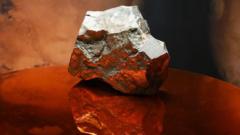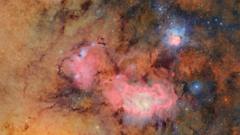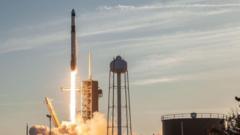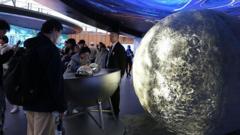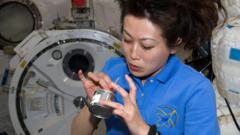An experimental device developed by Sierra Space is set to generate oxygen from moon-like soil, which could significantly reduce mission costs and support future lunar inhabitants. As various teams work on extracting vital resources from the lunar surface, the quest for self-sufficiency in space exploration intensifies.
Advancements in Lunar Oxygen Production Pave the Way for Sustainable Moon Bases
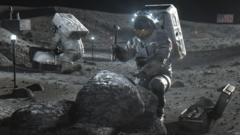
Advancements in Lunar Oxygen Production Pave the Way for Sustainable Moon Bases
Sierra Space's innovative technology aims to produce oxygen from lunar regolith, essential for future moon missions.
In a monumental step toward sustainable lunar habitation, Sierra Space has been testing a novel device designed to generate oxygen from lunar soil, known as regolith. Inside a specially constructed chamber at NASA's Johnson Space Center, engineers meticulously observed their silvery contraption equipped with vibrant wires – the driving force behind their ambitious plan to produce oxygen on the moon. The device began its transformation journey by processing small amounts of simulated regolith, a combination of dust and grit that mimics the chemical compositions found on the lunar surface.
As temperatures soared above 1,650°C, the dust reacted with added chemicals, releasing oxygen-containing molecules in a bubbling display. “We’ve tested everything we can on Earth now,” remarked Brant White, Sierra Space's program manager. The next challenge? Shifting the operation to the moon, potentially by 2028, when astronauts will require local sources of oxygen not only for respiration but also for rocket fuel for interplanetary missions.
With the upcoming Artemis mission poised to land astronauts on the moon in 2027, there’s growing urgency in developing technologies that exploit lunar resources. Extracting oxygen from the regolith could drastically cut down on mission costs, which otherwise would be inflated by transporting supplies from Earth. The moon's surface is teeming with metal oxides, which present an opportunity to derive metals necessary for construction and manufacturing.
To combat the unique challenges of the moon's environment, Sierra Space’s tests recreated the vacuum and temperature conditions of the moon's surface. However, the abrasive nature of lunar dust has posed operational challenges, leading to ongoing improvements in the design. Unlike Earth, the moon's lower gravity complicates extraction processes, particularly methods that rely on bubble formation, such as molten regolith electrolysis. According to Paul Burke from Johns Hopkins University, the sluggish ascent of oxygen bubbles could hinder extraction efficiency.
Sierra Space’s carbothermal technique, on the other hand, facilitates free formation of oxygen bubbles, reducing the risk of entrapment. Given that astronauts require significant daily oxygen resources, developing an efficient extraction method is crucial for sustaining life in a lunar habitat. Oxygen-producing technologies will also be essential for creating rocket propellant for ambitious missions beyond the moon.
Joining the space resource extraction efforts, MIT’s Palak Patel has devised a molten regolith electrolysis system that seeks to minimize dependency on Earth-supplied materials. Their approach includes employing a “sonicator” to effectively release the oxygen bubbles trapped during the electrolysis process. Researchers believe that extracting metals like iron, titanium, and lithium could enable the production of vital equipment on the moon itself, further enhancing self-sufficiency.
Innovative projects extend beyond oxygen production, with Patel's team transforming simulated lunar regolith into durable, glass-like bricks, highlighting the versatility of lunar materials. These advancements signal an exciting future of resource utilization on the moon, paving the way for long-term exploration and habitation. As humanity endeavors to return to the moon, the potential for building a sustainable lunar presence draws nearer, with developments grounded in real-time solutions and cutting-edge research.

